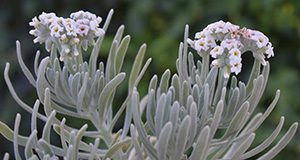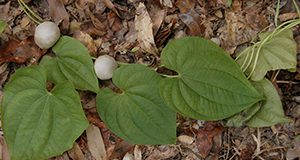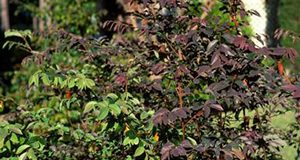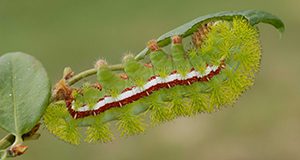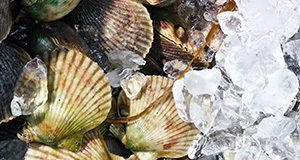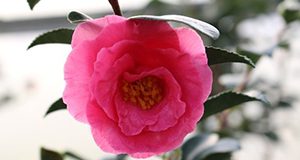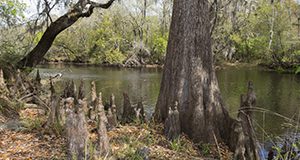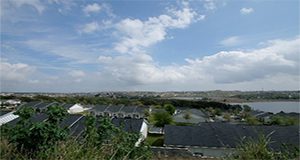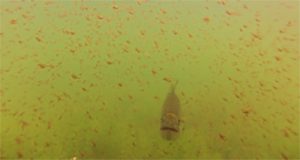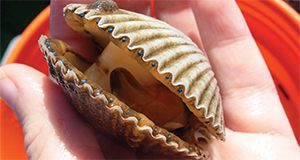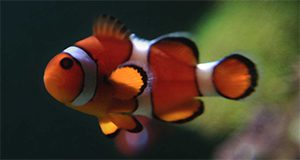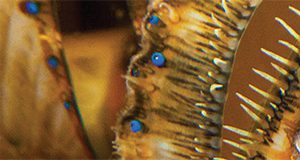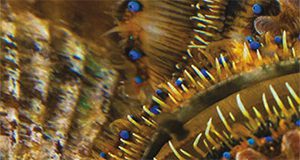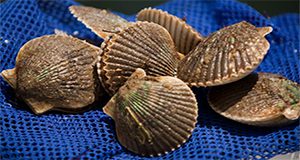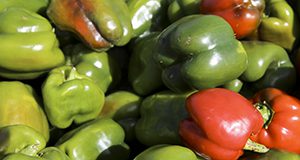Ocean acidification is the ongoing decrease in ocean pH caused primarily by the ocean’s taking up excess carbon dioxide from the atmosphere. Other impacts related to climate change (increased sea level rise, coastal flooding and extreme weather events) often receive more attention, but the acidification of the Earth’s oceans is well documented and is a major concern for the marine science community. This 4-page fact sheet written by Joshua Patterson and Lisa Krimsky and published by the UF/IFAS Program in Fisheries and Aquatic Sciences, School of Forest Resources and Conservation is the first in a series that addresses ocean acidification in Florida. It specifically explains the changes that are occurring to the chemistry of our coastal and oceanic waters because of elevated carbon dioxide levels. Additional publications address potential environmental, economic, and social implications for Florida.
http://edis.ifas.ufl.edu/fa206
Category: Environment
Sea Lavender (Heliotropium gnaphalodes L.): Identification and Uses
Sea lavender is a native plant found naturally along the Atlantic coast of central and south Florida. This 7-page document discusses this species’ identification and uses. Written by Stephen H. Brown, Marc S. Frank, and Andrew K. Koeser and published by the UF/IFAS Environmental Horticulture Department, August 2018.
http://edis.ifas.ufl.edu/ep563
Integrated Management of Non-Native Plants in Natural Areas of Florida
While natural areas are conservation lands that have been set aside for the purpose of preserving (or restoring) native plant and animal communities, they do require active management. One of the greatest management issues in natural areas is invasive plants. This 35-page publication provides land managers in Florida with current methods used to manage non-native plants. Written by Stephen F. Enloe, Ken Langeland, Jason Ferrell, Brent Sellers, and Greg MacDonald, and published by the UF/IFAS Agronomy Department, revised July 2018.
http://edis.ifas.ufl.edu/wg209
Key Plant, Key Pests: Chinese Fringe (Loropetalum chinense)
This 3-page document is one in the Key Plant, Key Pests series. It helps identify common pests found on the Chinese fringe. Written by Juanita Popenoe, Caroline R. Warwick, and Jianjun Chen and published by the UF/IFAS Environmental Horticulture Department, July 2018.
http://edis.ifas.ufl.edu/ep562
Stinging and Venomous Caterpillars of the Southeast
Wasp and bee stings are familiar to most people, but some might be surprised to learn that several caterpillars can also sting. Unlike wasps and bees with stingers, these caterpillars have barbed hairs that break off the caterpillar when it brushes against something. The hairs embed in skin and cause sudden or gradually building pain. The severity of a caterpillar sting varies based on the person and number of spines in the skin. Many stinging caterpillars also release a toxin on contact, which may cause health problems for some people. This 4-page fact sheet written by Rebecca Perry and Adam Dale and published by the UF/IFAS Department of Entomology and Nematology describes several stinging caterpillars commonly found throughout the southeastern United States.
https://edis.ifas.ufl.edu/in014
Feral Swine Trapping: Techniques and Designs
Feral swine are an invasive or nuisance species in Florida and most other states because their incessant rooting is ruinous to natural and agricultural habitat. They loosen the soil, destroy native vegetation, and modify the natural chemistry and nutrients of the soil, causing widespread destruction in natural ecosystems, agricultural areas, livestock pastures, and residential areas. They also carry numerous diseases, some of which are transmittable to wild and domestic animals and humans. Trapping and removing swine from your property is an effective way to reduce or control feral swine populations. This 9-page fact sheet written by Bethany Wight and Raoul K. Boughton and published by the UF/IFAS Wildlife Ecology and Conservation Department describes the most commonly used trapping techniques and illustrates several trap and gate designs.
https://edis.ifas.ufl.edu/uw440
Best Practices for Scalloping: From the Boat to Your Plate
Recreational scalloping in Florida is a popular group activity for many residents and visitors throughout the summer months. This 6-page fact sheet written by Brittany Hall-Scharf, Sarah Ellis, and Savanna Barry and published by the UF/IFAS Florida Sea Grant College Program lists the legal requirements for boating and scalloping, provides a safety plan to minimize and/or prevent accidents while you’re out on the water, and explains proper shucking methods to ensure that the meals you make from your catch will be safe and delicious.
https://edis.ifas.ufl.edu/sg158
Key Plant, Key Pests: Crapemyrtle (Lagerstroemia)
This 4-page document is one in the Key Plant, Key Pests series. It helps identify pests found on the crapemyrtle, one of the most common landscape plants in north and central Florida. Written by Juanita Popenoe, Caroline R. Warwick, and Chris Marble and published by the UF/IFAS Environmental Horticulture Department, June 2018.
http://edis.ifas.ufl.edu/ep560
Key Plant, Key Pests: Camellia
This 7-page document is one in the Key Plant, Key Pests series. It discusses identification and management of pests found on the camellia, a flowering plant common in Southern landscapes. Written by Juanita Popenoe, Caroline R. Warwick, and Brian Pearson and published by the UF/IFAS Environmental Horticulture Department, June 2018.
http://edis.ifas.ufl.edu/ep558
Key Plant, Key Pests: Baldcypress (Taxodium distichum)
This 4-page document is one in the Key Plant, Key Pests series. It provides information on the management of common pests found on baldcypress. Written by Juanita Popenoe, Caroline R. Warwick, and Roger Kjelgren and published by the UF/IFAS Environmental Horticulture Department, June 2018.
http://edis.ifas.ufl.edu/ep557
A Brief Summary of the Water Bill, SB 552
This 5-page document written by Lisa Krimsky, Andrea Albertin, Charles Barrett, James Fletcher, and Mary Lusk and published by the UF/IFAS Program in Fisheries and Aquatic Sciences of the School of Forest Resources and Conservation is intended to act as a quick reference guide and is not inclusive of all measures in SB 552. This summary addresses the Florida Springs and Aquifer Protection Act, the Central Florida Water Initiative, Northern Everglades and Estuaries Protection, and Pilot Programs for Alternative Water Supply.
http://edis.ifas.ufl.edu/fa205
Bed Fishing for Florida Bass
Florida bass, Micropterus floridanus, is the most popular freshwater sport fish in the state of Florida. Florida bass guard their nests for up to 2 weeks, and many anglers target the prized sport fish during this period using a procedure called bed fishing. This 7-page fact sheet written by John S. Hargrove and James D. Austin and published by the UF/IFAS School of Forest Resources and Conservation, Program in Fisheries and Aquatic Sciences, outlines the reproductive biology of Florida bass, the known consequences of bed fishing, and practices to minimize its impacts.
http://edis.ifas.ufl.edu/fa204
Cat’s-Claw Vine, Dolichandra unguis-cati : A Showy but Invasive Plant in Florida
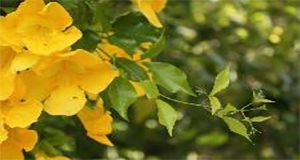
Cat’s-claw vine is a neotropical, climbing perennial that produces large and showy yellow flowers in the springtime. Unfortunately, the aggressive nature of the vine has made it a major weed in China, Australia, South Africa, and parts of the southeastern United States. This 6-page fact sheet written by Niels Proctor and Jason Smith and published by the UF/IFAS School of Forest Resources and Conservation provides guidance on identification and control of this invasive vine and suggests some similar native vines to use instead.
http://edis.ifas.ufl.edu/fr391
Recreational Harvesting of the Florida Bay Scallop: Taylor County
This useful brochure includes a full-color map identifying access routes to the boat ramps and marinas in southern Taylor County near Steinhatchee and Keaton Beach plus the latest information on scallops and scalloping, the recommended equipment you will want to bring, and a few tasty recipes for preparing Florida’s best summertime catch. Written by Victor Blanco and published by the UF/IFAS Extension Florida Sea Grant College Program.
http://edis.ifas.ufl.edu/sg146
Recreational Harvest of the Florida Bay Scallop: Hernando County
This useful brochure written by Brittany Hall-Scharf and published by the UF/IFAS Florida Sea Grant College Program includes a full-color map identifying access routes to the boat ramps and marinas in Hernando County. Also find the latest information on scallops and scalloping, the recommended equipment you will want to bring, and a few tasty recipes for preparing Florida’s best summertime catch.
http://edis.ifas.ufl.edu/sg148
How Ornamental Fishes Get Their Color
Color in fish is mostly genetically determined, but they are unable to produce red, orange, yellow, green, and some blue colors themselves.They get these colors from their food. Fish raised in aquariums or recirculating water systems without pigment supplementation in their diet will fade and lose their vibrant hues. Even in ponds, dietary pigment supplementation can make fishes brighter and more variably colored, just like their wild counterparts. This 6-page fact sheet written by F. A. Chapman and R. D. Miles and published by the UF/IFAS School of Forest Resources and Conservation, Program in Fisheries and Aquatic Sciences, addresses how ornamental fish get their colors and provides a list of ingredient sources for diets that can be used to enhance and intensify fish colors.
Recreational Harvesting of the Florida Bay Scallop: Wakulla County
This handy brochure includes a full-color map identifying access routes to the boat ramps and marinas in Wakulla County, plus the latest information on scallops and scalloping, the recommended equipment you will want to bring, and a few tasty recipes for preparing Florida’s best summertime catch. Written by Savanna Barry and published by the UF/IFAS Extension Florida Sea Grant College Program.
http://edis.ifas.ufl.edu/sg149
Recreational Harvesting of the Florida Bay Scallop: Citrus County
This handy brochure written by Savanna Barry and published by the UF/IFAS Florida Sea Grant College Program includes a full-color map identifying access routes to the boat ramps and marinas in Citrus County near Homosassa and Crystal River, plus the latest information on scallops and scalloping, the recommended equipment you will want to bring, and a few tasty recipes for preparing Florida’s best summertime catch.
http://edis.ifas.ufl.edu/sg147
Recreational Harvesting of the Florida Bay Scallop: Pasco County
This useful brochure written by Brittany Hall-Scharf and published by the UF/IFAS Extension Florida Sea Grant College Program includes a full-color map identifying access routes to the boat ramps and marinas in Pasco County, plus the latest information on scallops and scalloping, the recommended equipment you will want to bring, and a few tasty recipes for preparing Florida’s best summertime catch.
http://edis.ifas.ufl.edu/sg157
Pest Identification Guide: Solanum (Pepper) Whitefly, Aleurotrachelus trachoides
Considered an emerging pest in Florida, the solanum whitefly has been in the state since at least the 1960s. It eats pepper, eggplant, and tomato, as well as other food crops, ornamental plants, and weeds. Learn to identify the little pest with this handy, 2-page guide written by Nicole A. Casuso and Hugh A. Smith and published by the UF/IFAS Entomology and Nematology Department.
http://edis.ifas.ufl.edu/in1201

